An In Silico In Vitro and In Vivo Study on the Influence of an Eggplant Fruit (Solanum anguivi Lam) Diet on Metabolic Dysfunction in the Sucrose-Induced Diabetic-like Fruit Fly (Drosophila melanogaster)
Abstract
1. Introduction
2. Materials and Methods
2.1. Sample Collection
2.2. Mineral and Vitamin Determination
2.3. Preparation of Aqueous Extracts of Eggplant Fruits
2.4. Total Phenol Content
2.5. Total Flavonoid Content
2.6. In Vitro Enzyme Assays
2.6.1. Assay for Cyclooxygenase Activity
2.6.2. Assay for 5-Lipoxygenase Activity
2.6.3. α-Amylase Assay
2.6.4. α-Glucosidase Assay
2.7. In Vivo Study
2.7.1. Feed Formulation and Survival Study
2.7.2. Experimental Design and Biological Assays
2.8. In Silico Study
2.9. Data Analysis
3. Results
3.1. Phenolic Characterization Using HPLC–UV
3.2. Vitamins and Minerals
3.3. Phenolic and Flavonoid Content
3.4. Cyclooxygenass (COX), Lipoxygenase (5-LOX), α-Amylase, and α-Glucosidase Activities
3.5. Effect of the Ripe and Unripe Eggplant-Inclusive Diets on Weight and Movement
3.6. Effect of the Ripe and Unripe Eggplant-Inclusive Diets on α-Amylase and α-Glucosidase
3.7. Effect of the Ripe and Unripe Eggplant Diets on the Glucose Level
3.8. Effect of the Eggplant Diets on ROS, MDA, and Total Thiols
3.9. Effect of the Eggplant Diets on Endogenous Antioxidants in a Cell-Based System
3.10. In Silico Results
4. Discussion
5. Conclusions
Supplementary Materials
Author Contributions
Funding
Institutional Review Board Statement
Informed Consent Statement
Data Availability Statement
Acknowledgments
Conflicts of Interest
References
- Karuranga, S.; Malanda, B.; Saeedi, P.; Salpea, P. (Eds.) IDF Diabetes Atlas, 9th ed.; IDF: Brussels, Belgium, 2019. [Google Scholar]
- Fougere, B.; van Kan, G.A.; Vellas, B.; Cesari, M. Redox Systems, Antioxidants and Sarcopenia. Curr. Protein. Pept. Sci. 2018, 19, 643–648. [Google Scholar] [CrossRef] [PubMed]
- Abolaji, A.O.; Fasae, K.D.; Iwezor, C.E.; Aschner, M.; Farombi, O.E. Curcumin attenuates cop per-induced oxidative stress and neurotoxicity in Drosophila melanogaster. Toxicol. Rep. 2020, 7, 261–268. [Google Scholar] [CrossRef]
- Manzoor, U.; Ali, A.; Ali, S.L. Mutational screening of GDAP1 in dysphonia associated with Charcot-Marie-Tooth disease: Clinical insights and phenotypic effects. J. Genet. Eng. Biotechnol. 2023, 21, 1–11. [Google Scholar] [CrossRef]
- Oyeniran, O.H.; Ademiluyi, A.O.; Oboh, G. African mistletoe (Tapinanthus bangwensis Lor.) infestation improves the phenolic constituents, antioxidative and antidiabetic effects of almond (Terminalia catappa Linn.) host leaf in sucrose-rich diet-induced diabetic-like phenotypes in fruit fly. Drosoph. Melanogaster. Meigen Food Front. 2021, 2, 77–90. [Google Scholar] [CrossRef]
- Ecker, A.; do Nascimento Gonzaga, T.K.S.; Seeger, R.L.; dos Santos, M.M.; Loreto, J.S.; Boligon, A.A.; Barbosa, N.V. High-sucrose diet induces diabetic-like phenotypes and oxidative stress in Drosophila melanogaster: Protective role of Syzygium cumini and Bauhinia forficata. Biomed. Pharmacother. 2017, 89, 605–616. [Google Scholar] [CrossRef]
- Garelli, A.; Gontijo, A.M.; Miguela, V.; Caparros, E.; Dominguez, M. Imaginal discs secrete insulin-like peptide 8 to mediate plasticity of growth and maturation. Science 2012, 336, 579–582. [Google Scholar] [CrossRef] [PubMed]
- Dan, C.G.; Kouassi, K.N.; Ban, K.L.; Nemlin, G.J.; Kouame, P.L. Influence of maturity stage on nutritional and therapeutic potentialities of Solanum anguivi lam Lam berries (Gnagnan) cultivated in Côte d’Ivoire. Intern. J. Nutri. Food Sci. 2014, 3, 1–5. [Google Scholar]
- Nwanna, E.E. Protective effect of alkaloid-rich extract of Brimstone tree (Morinda lucida) on Neurotoxicity in the fruit-fly (Drosophila melanogaster) model. Afr. J. Biomed. Res. 2020, 24, 257–263. [Google Scholar]
- Okokon, J.E.; Etuk, I.C.; Udobang, J.A.; Ebong, N.O. In-vivo Alpha-Amylase and Alpha-Glucosidase Inhibitory Activities of Solanum anomalum Leaf Extract and Fractions. Biol. Med. Nat. Prod. Chem. 2023, 12, 127–132. [Google Scholar] [CrossRef]
- Reyes-De-Corcuera, J.I.; Goodrich-Schneider, R.M.; Barringer, S.A.; Landeros-Urbina, M.A. Processing of fruit and vegetable beverages. Food Process Princ. Appl. 2014, 339–362. [Google Scholar] [CrossRef]
- Nwanna, E.E.; Ibukun, E.O.; Oboh, G. Nutritional content of selected species of tropical eggplant fruit (Solanum spp.) diet Attenuates hepatic inflammation in high-fat fed male Wistar rats induced with streptozotocin. Food Sci. Nutr. 2019, 7, 109–119. [Google Scholar] [CrossRef]
- AOAC—Association of Official Analytical Chemists. Official Methods of Analysis of AOAC International, 18th ed.; AOAC: Gaithersburg, MD, USA, 2007. [Google Scholar]
- Perkin- Elmer Cor Poration. Analytical Methods for Atomic Absorption Spectrophotometry; Perkin-Elmer Corporation: Norwalk, CT, USA, 1982. [Google Scholar]
- FAO. Manual of Food Quality Control: Chemical Analysis; Food and Agricultural Organization: Rome, Italy, 1992. [Google Scholar]
- Benderitter, M.; Maupoli, V.; Vergely, C.; Dalloz, F.; Briot Rochette, L. Studies by electronparamagnetic resonance of the important of iron in hydroxyl scavenging properties of ascorbic acid in plasma: Effects of iron chelators. Funda Clin. Pharmaco. 1998, 12, 510–516. [Google Scholar] [CrossRef]
- Suzuki, J.; Katoh, N. A simple and cheap method for measuring serum vitamin A in cattle using only a spectrophotometer. Jpn. J. Vet. Sci. 1990, 52, 1281–1283. [Google Scholar] [CrossRef]
- Orsavová, J.; Hlaváčová, I.; Mlček, J.; Snopek, L.; Mišurcová, L. Contribution of phenolic compounds, ascor bic acid and vitamin E to antioxidant activity of currant (Ribes L.) and gooseberry (Ribes uva-crispa L.) fruits. Food Chem. 2019, 284, 323–333. [Google Scholar] [CrossRef] [PubMed]
- Yan, X.; Wang, W.; Zhang, L.; Zhao, Y.; Xing, D.; Du, L. A high-performance liquid chromatography with UV-vis detection method for the determination of brazilein in plant extract. J. Chromatogr. Sci. 2007, 45, 212–215. [Google Scholar] [CrossRef][Green Version]
- Nwanna, E.E.; Ibukun, E.O.; Oboh, G. Nutritional contents and antioxidant activities of African garden egg (Solanum aethiopium) cultivars. Adv. Food Sci. 2013, 35, 30–36. [Google Scholar]
- Singleton, V.L.; Orthofer, R.; Lamuela-Raventós, R.M. Analysis of total phenols and other oxidation substrates and antioxidants by means of Folin-Ciocalteau’s reagent. Method Enzymol. 1999, 299, 152–178. [Google Scholar]
- Meda, A.; Lamien, C.E.; Romito, M.; Millogo, J.; Nacoulma, O.G. Determination of the total phenolic, flavonoid and proline contents in Burkina Fasan honey, as well as their radical scavenging activity. Food Chem. 2005, 91, 571–577. [Google Scholar] [CrossRef]
- Viji, V.; Helen, A. Inhibition of lipoxygenases and cyclooxygenase-2 enzymes by extracts isolated from Bacopa Monniera (L.) Wettst. J. Ethnopharmacol. 2008, 118, 305–311. [Google Scholar] [CrossRef] [PubMed]
- Worthington, K. Alpha Amylase Worthington Enzyme Manual; Worthington Biochemical: Lakewood, NJ, USA, 1993; pp. 36–41. [Google Scholar]
- Apostolidis, E.; Kwon, Y.I.; Shetty, K. Inhibitory potential of herb, fruit, and fungal- enrichedcheese against key enzymes linked to type 2 diabetes and hypertension. Innov. Food Sci. Emerg. Technol. 2007, 8, 46–54. [Google Scholar] [CrossRef]
- Bradford, M.M. A rapid and sensitive method for the quantitation of microgram quantities of protein utilizing the principle of protein-dye binding. Anal. Biochem. 1976, 72, 248. [Google Scholar] [CrossRef]
- Hayashi, I.; Morishita, Y.; Imai, K.; Nakamura, M.; Nakachi, K.; Hayashi, T. High through put spectrophotometric assay of reactive oxygen Species in serum. Mutat. Res. 2007, 631, 55–61. [Google Scholar] [CrossRef] [PubMed]
- Ohkawa, H.; Ohishi, N.; Yagi, K. Assay for lipid peroxides in animal tissues by thiobarbituric acid reac tion. Anal. Biochem. 1979, 95, 351–358. [Google Scholar] [CrossRef] [PubMed]
- Ellman, G.L. Tissue sulfhydryl groups. Arch. Biochem. Biophys. 1959, 82, 70. [Google Scholar] [CrossRef]
- Shina, A.K. Colorimetric assay of catalase. Anal. Biochem. 1972, 47, 389–394. [Google Scholar]
- Habig, W.H.; Jakoby, W.B. Assays for differentiation of glutathione-S-transferases. Methods Enzymol. 1981, 77, 398–405. [Google Scholar]
- Jewett, S.L.; Rocklin, A.M. Variation in one unit of activity with oxidation rate of organic substrate in indirect superoxide dismutase assays. Annu. Rev. Biochem. 1993, 212, 55–59. [Google Scholar] [CrossRef]
- Pettersen, E.F.; Goddard, T.D.; Huang, C.C.; Couch, G.S.; Greenblatt, D.M.; Meng, E.C. UCSF Chimera - A visualization system for exploratory research and analysis. J. Comput. Chem. 2004, 25, 1605–1612. [Google Scholar] [CrossRef]
- Umar, H.I.; Awonyemi, I.O.; Abegunde, S.M.; Igbe, F.O.; Siraj, B. In silico molecular docking of bioactive molecules isolated from Raphia taedigera seed oil as potential anti-cancer agents targeting vascular endothelial growth factor receptor-2. Chem. Afr. 2021, 4, 161–174. [Google Scholar] [CrossRef]
- Zar, J.H. Biostatistical Analysis; Prentice-Hall: Saddle River, NJ, USA, 1999; 620p, ISBN 0-13-081542-X. [Google Scholar]
- Man, M.-Q.; Yang, B.; Elias, P.M. Benefits of hesperidin for cutaneous functions. Evid.-Based Complement. Altern. Med. 2019, 2019, 2676307. [Google Scholar] [CrossRef]
- Chen, R.; Qi, Q.-L.; Wang, M.-T.; Li, Q.-Y. Therapeutic potential of naringin: An overview. Pharma. Biol. 2016, 54, 3203–3210. [Google Scholar] [CrossRef]
- Taheri, Y.; Suleria, H.A.R.; Martins, N.; Sytar, O.; Beyatli, A.; Yeskaliyeva, B.; Seitimova, G.; Salehi, B.; Semwal, P.; Painuli, S.; et al. Myricetin bioactive effects: Moving from preclinical evi dence to potential clinical applications. BMC Complement. Med. Ther. 2020, 20, 241. [Google Scholar] [CrossRef]
- Ijarotimi, O.S.; Ekeh, O.; Ajayi, O.P. Nutrient composition of selected medicinal leafy vegetables in Western Nigeria. J. Med. Food 2010, 13, 476–479. [Google Scholar] [CrossRef] [PubMed]
- Maduwanthi, S.D.T.; Marapana, R.A.U. Induced Ripening Agents and Their Effect on Fruit Quality of Banana. Int. J. Food Sci. 2019, 2019, 2520179. [Google Scholar] [CrossRef] [PubMed]
- Cuendet, M.; Pezzuto, M. The role of cyclooxygenase and lipoxygenase in cancer chemoprevention. Drug Metab. Drug Interact. 2000, 17, 109–158. [Google Scholar] [CrossRef] [PubMed]
- Julémont, F.; Dogné, J.-M.; Pirotte, B.; Leval, X.D. Recent development in the field of dual COX/5-LOX inhibi tors. Mini Rev. Med. Chem. 2004, 4, 633–638. [Google Scholar] [CrossRef] [PubMed]
- Musselman, L.P.; Fink, J.L.; Narzinski, K.; Ramachandran, P.V.; Hathiramani, S.S.; Cagan, R.L.; Baranski, T.J. A high-sugar diet produces obesity and insulin resistance in wild-type. Drosoph. Dis. Models Mech. Anisms 2011, 4, 842. [Google Scholar] [CrossRef] [PubMed]
- Kathrin-Maria, R. Thiols and Organic Sulphides. In Ullmann’s Encyclopedia of Industrial Chemistry; Wiley-VCH: Weinheim, Germany, 2005. [Google Scholar] [CrossRef]
- McLeay, Y.; Stannard, S.; Houltham, S.; Starck, C. Dietary thiols in exercise: Oxidative stress defense, exercise performance, and adaptation. J. Int. Soc. Sports Nutr. 2007, 14, 12. [Google Scholar] [CrossRef]
- Aloud, A.A.; Veeramani, C.; Govindasamy, C.; Alsaif, M.A.; Al-Numair, K.S. Galangin, a natural flavonoid reduces mitochondrial oxidative damage in streptozotocin-induced diabetic rats. Redox Rep. 2018, 1, 29–34. [Google Scholar] [CrossRef]
- Thiyagarajan, R. Oxidative stress and hepatocellular mitochondrial dysfunction attenuated by asiatic acid in streptozotocin-induced diabetic rats. J. King Saud Univ. Sci. 2021, 33, 101369. [Google Scholar]
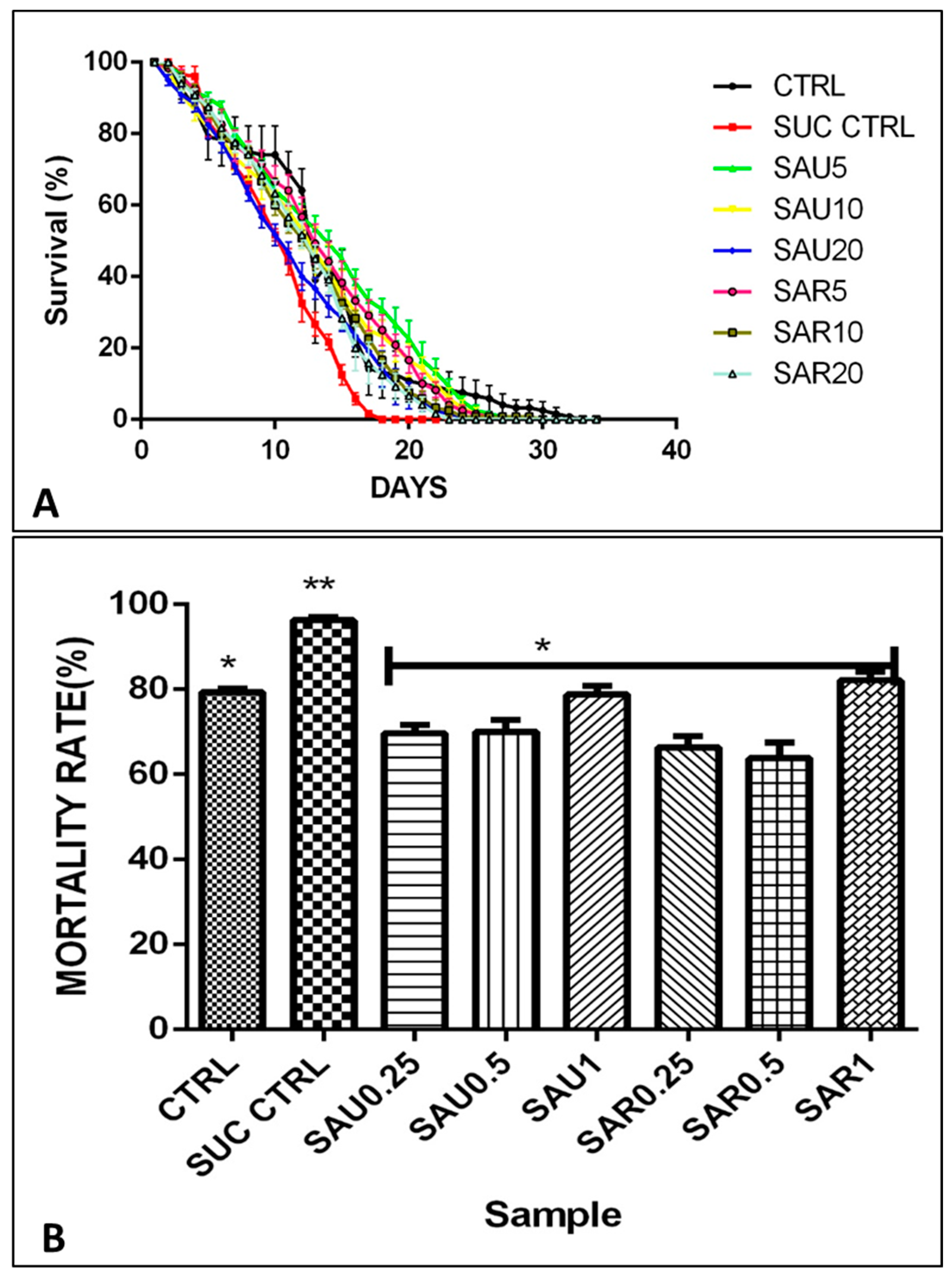
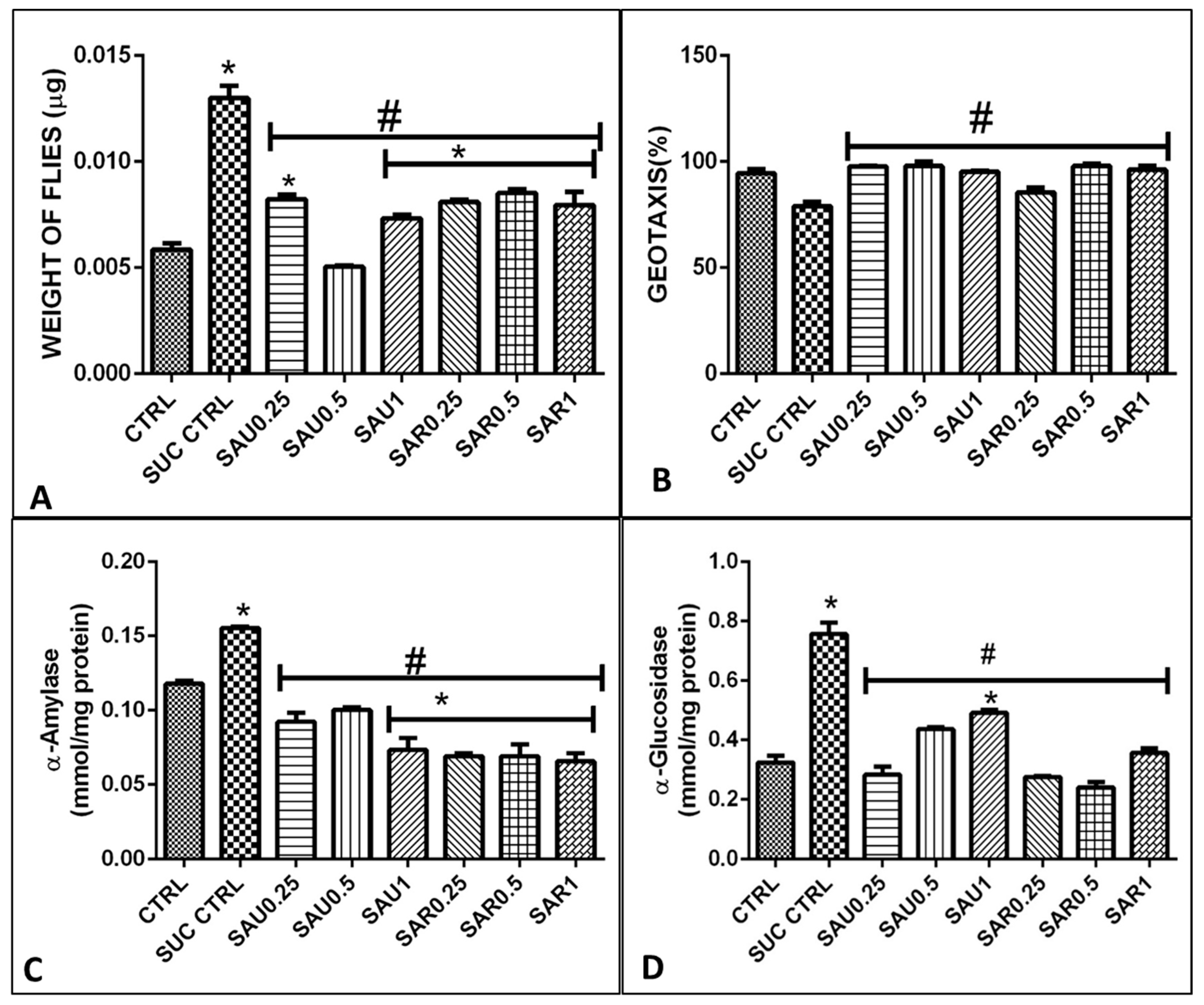
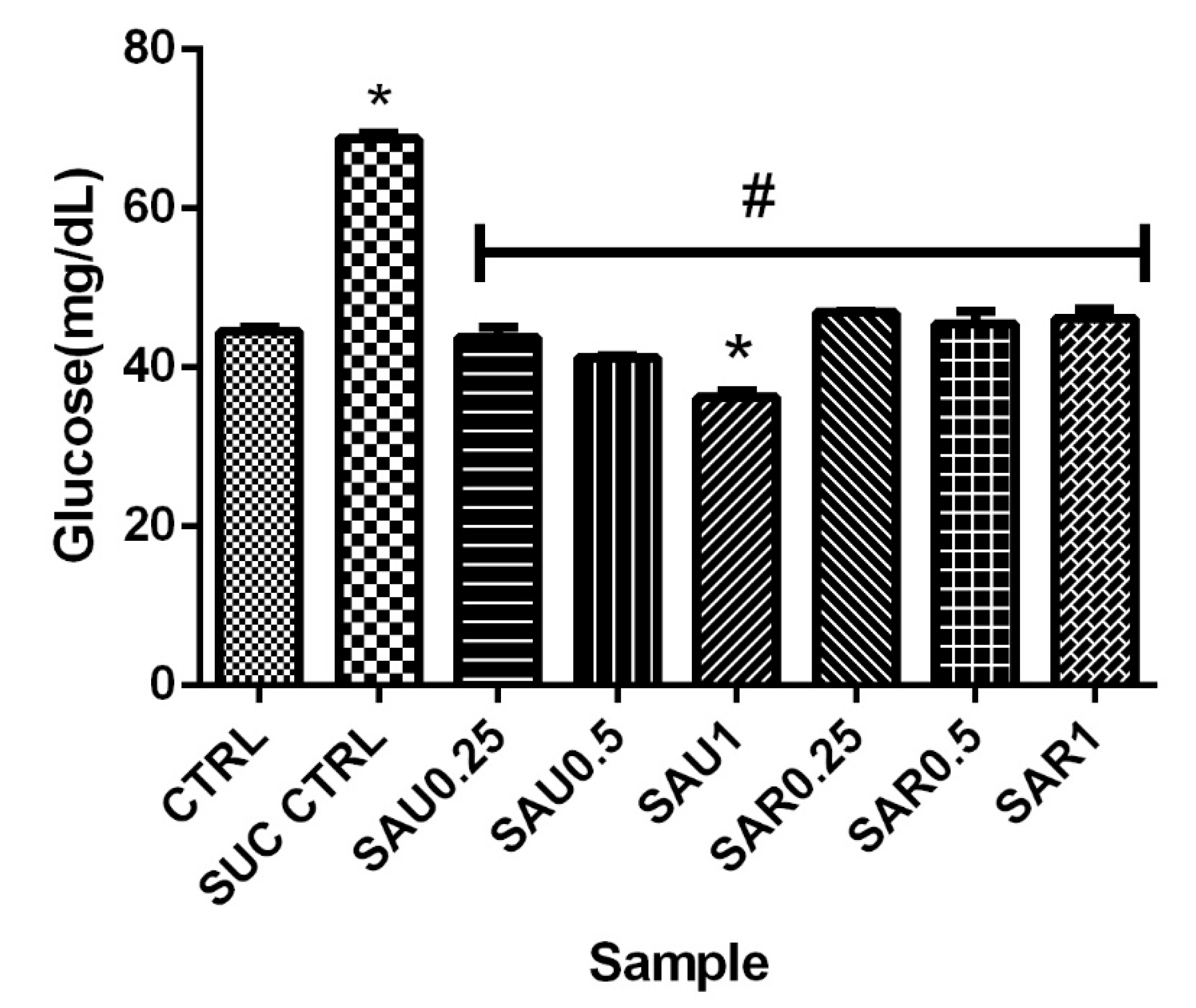
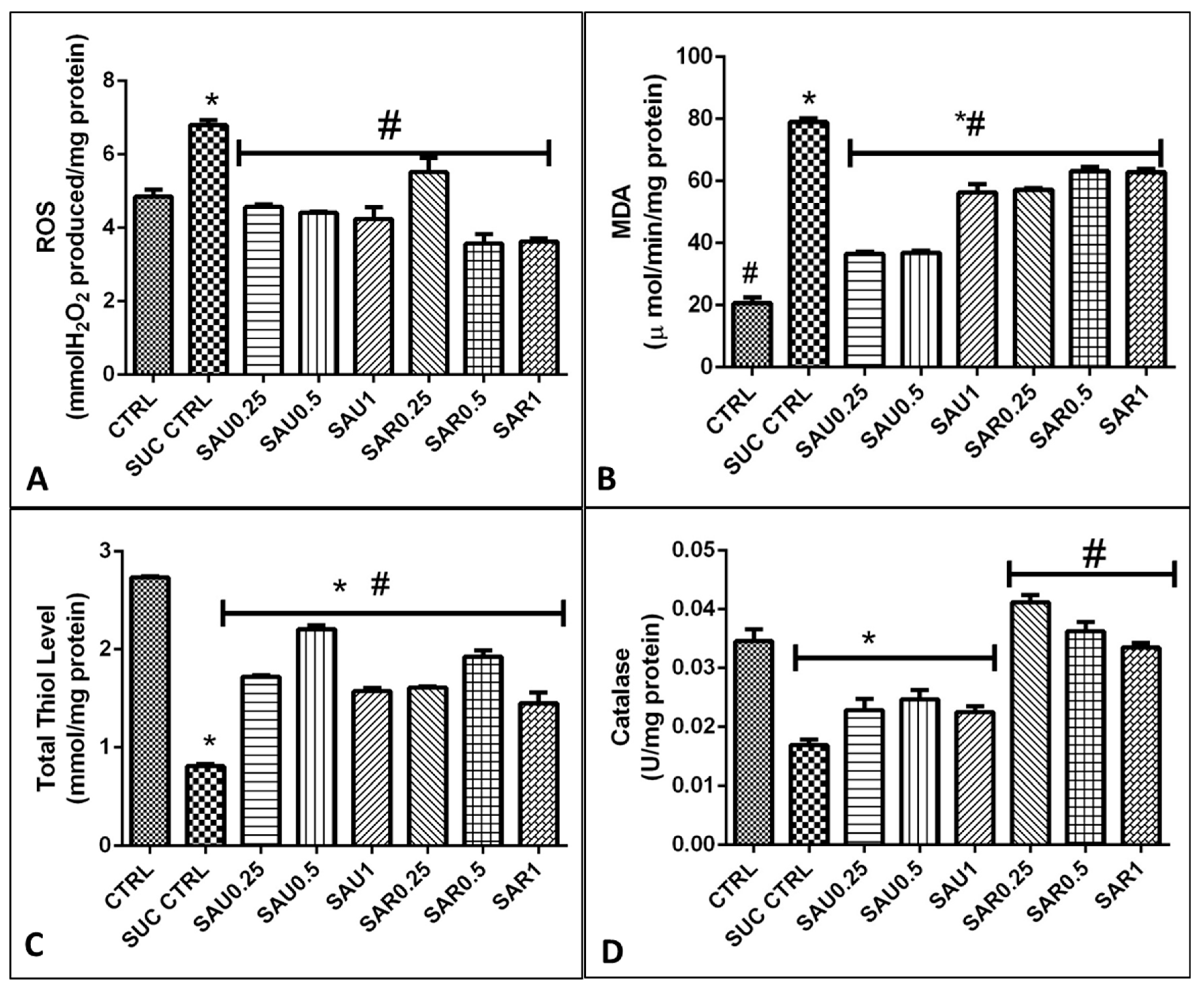
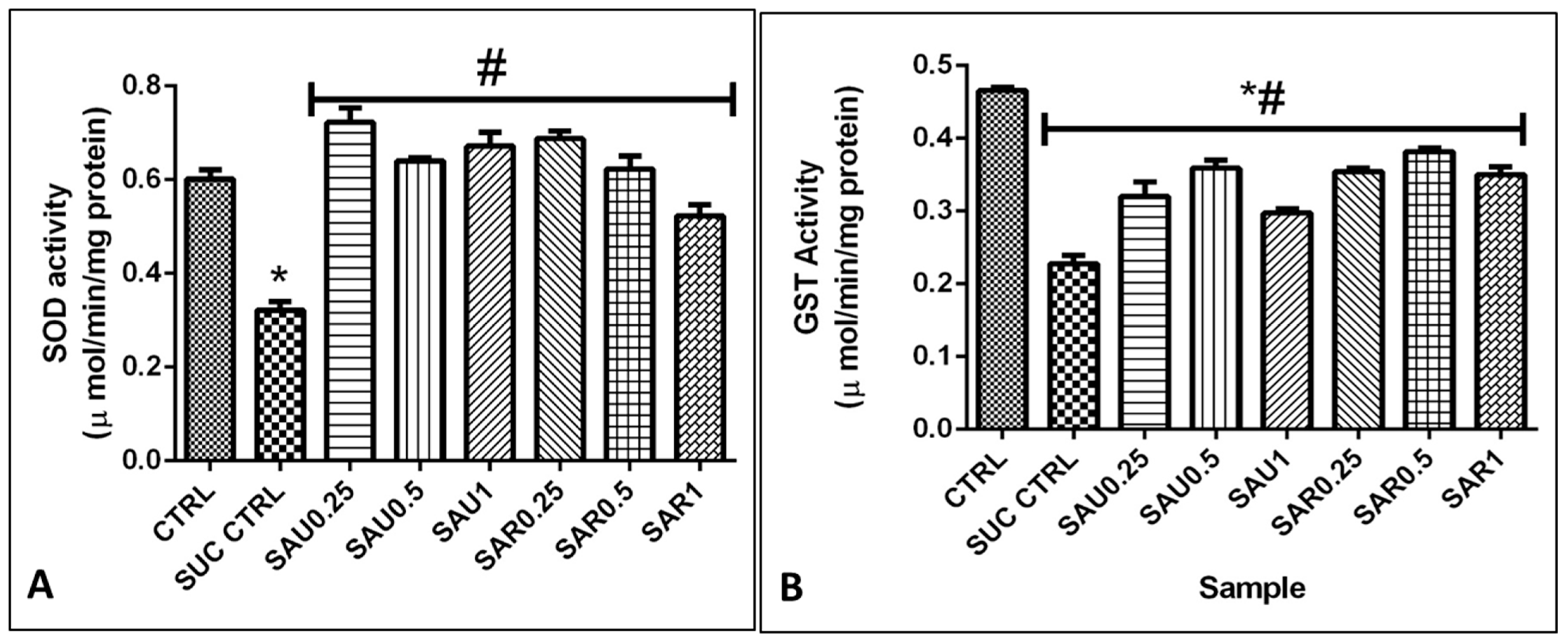
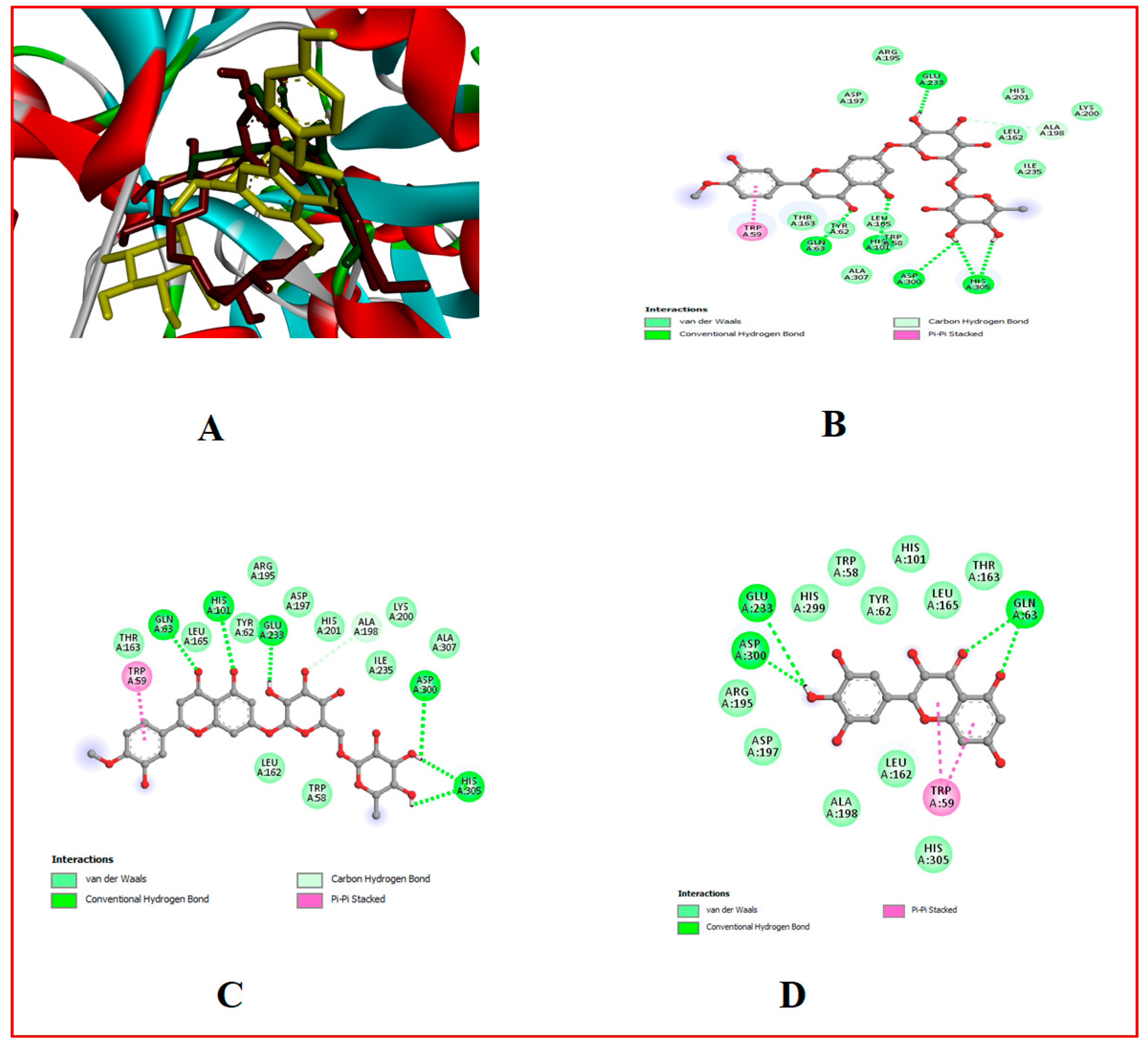
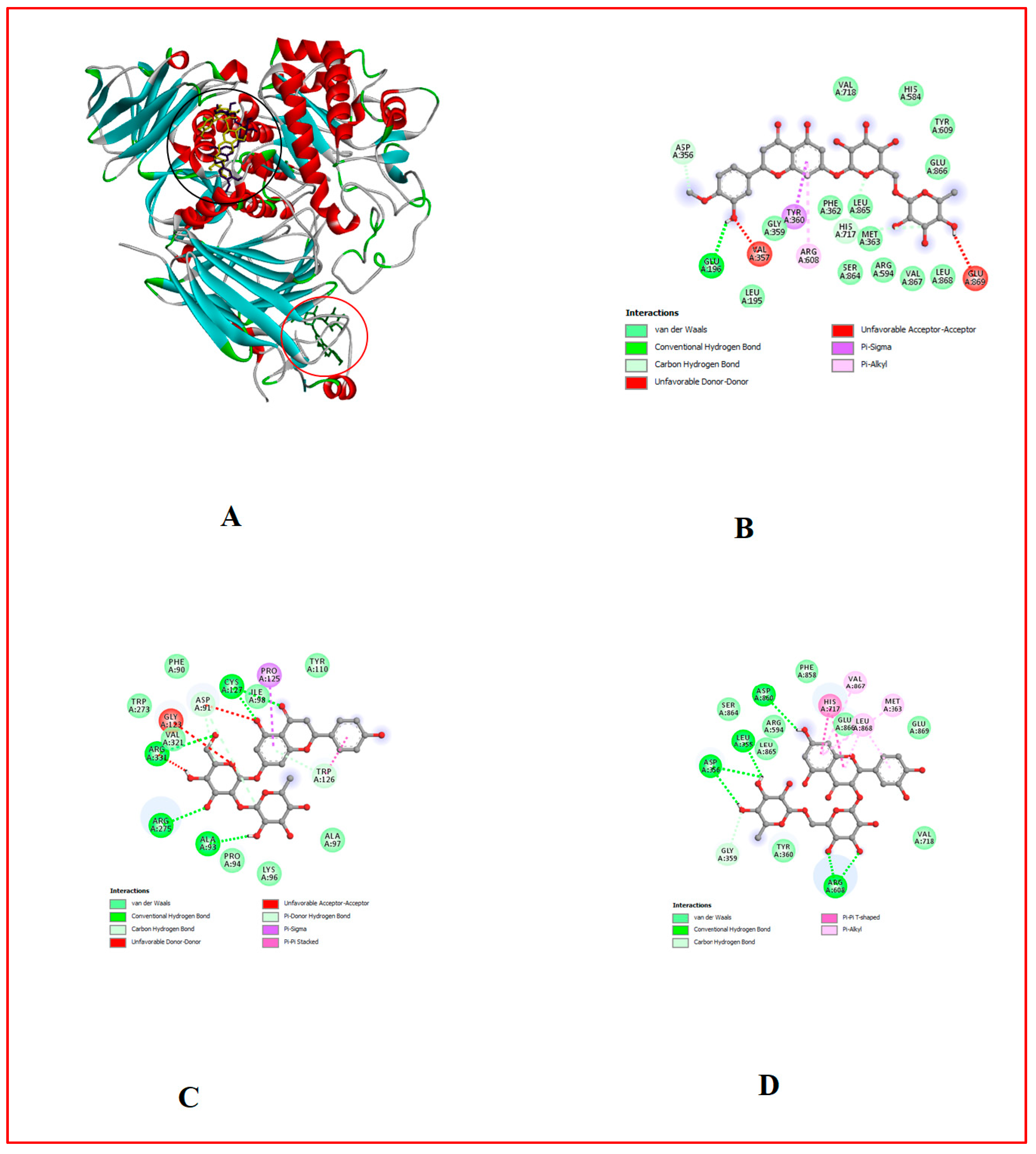
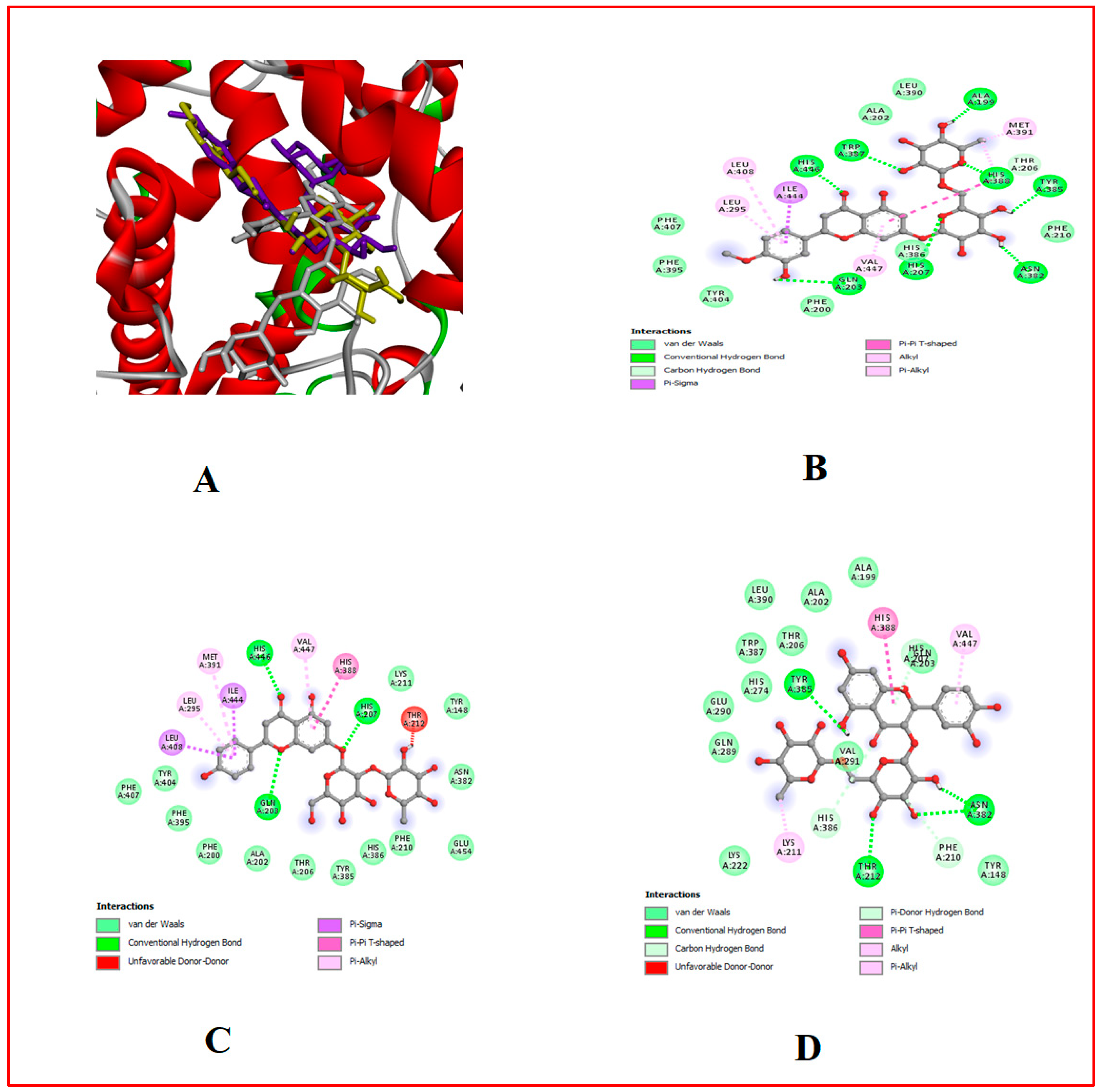
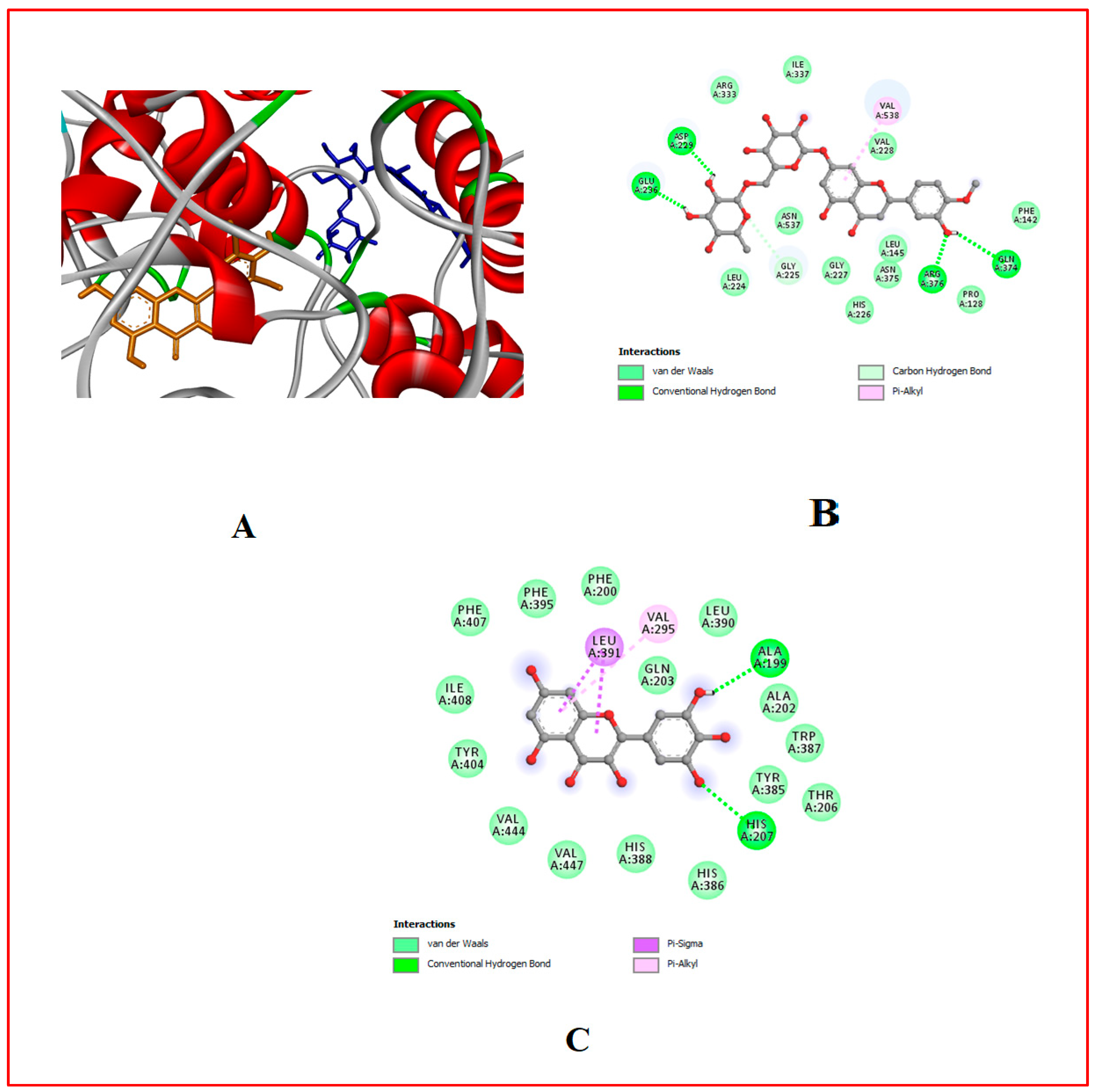
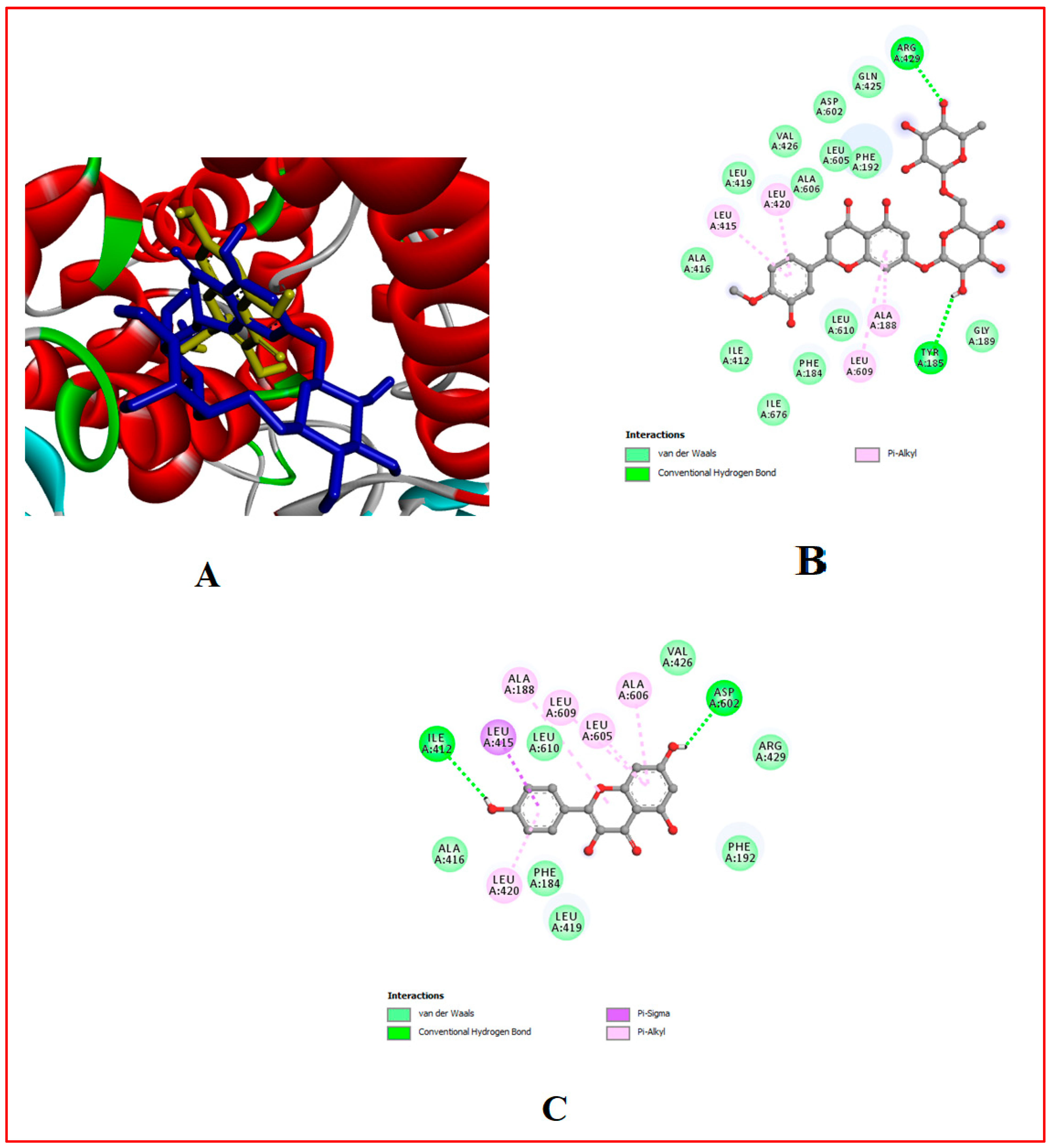
| Compounds | SAU (Unripe) | SAR (Ripe Fruit) |
|---|---|---|
| Rutin | 2.36 × 10−4 | 5.47 × 10−4 |
| Phenol | 669.27 | 620.95 |
| Vanillic acid | 1.14 × 10−5 | 2.82 × 10−5 |
| p-hydroxybenzoic acid | 4.52 × 10−6 | 9.49 × 10−6 |
| Cinnamic acid | 117.55 | 110.46 |
| Catechin | 1.20 × 10−2 | 1.35 × 10−2 |
| Gallic acid | 7.96 × 10−3 | 9.21 × 10−3 |
| Caffeic acid | 1.19 × 10−2 | 1.26 × 10−2 |
| Kaempferol | 472.27 | 458.37 |
| Syringic acid | 6.33 × 10−6 | 7.08 × 10−6 |
| Naringin | 1.09 × 10−6 | 1.38 × 10−6 |
| Piperic acid | 3.17 × 10−7 | 3.88 × 10−7 |
| Epicatechin | 4.16 × 10−4 | 4.94 × 10−4 |
| Quercetin | 448.35 | 377.16 |
| Myricetin | 235.37 | 218.59 |
| Chlorogenic acid | 375.06 | 366.30 |
| Isoquercitrin | 2.94 × 10−4 | 3.19 × 10−3 |
| Hesperidin | 1.01 × 10−3 | 3.53 × 10−3 |
| Total | 2354.94 | 2205.43 |
| Groups | Diets |
|---|---|
| Group 1 | Basal only |
| Group 2 | Sucrose-induced |
| Group 3 | Sucrose-induced + Unripe sample (0.25%) |
| Group 4 | Sucrose-induced + Unripe sample (0.50%) |
| Group 5 | Sucrose-induced + Unripe sample (1%) |
| Group 6 | Sucrose-induced + Ripe sample (0.25%) |
| Group 7 | Sucrose-induced + Ripe sample (0.50%) |
| Group 8 | Sucrose-induced + Ripe sample (1%) |
| Sample | Na | K | Ca | Mg | Fe | P | Zn |
|---|---|---|---|---|---|---|---|
| SAU | 46.80 ± 0.01 a | 78.01 ± 0.01 a | 29.02 ± 0.01 a | 47.50 ± 0.01 a | 4.71 ± 0.01 a | 8.31 ± 0.01 a | 2.95 ± 0.01 a |
| SAR | 54.10 ± 0.01 b | 82.01 ± 0.01 b | 23.50 ± 0.01 b | 53.10 ± 0.01 b | 7.01 ± 0.01 b | 7.83 ± 0.01 a | 3.05 ± 0.01 b |
| Sample | VIT A (mg/g) | VIT C (mg/g) | VIT E (mg/g) | Carotenoids (mg/g) |
|---|---|---|---|---|
| SAU | 12.39 ± 4.81 a | 57.9 ± 0.2 a | 0.45 ± 0.07 a | 7.52 ± 0.101 a |
| SAR | 16.76 ± 4.73 b | 81.0 ± 1.4 b | 2.24 ± 0.06 b | 9.06 ± 0.022 b |
| Parameters | Total Phenol (mg GAE/100 g) | Total Flavonoids (mg QUE/100 g) |
|---|---|---|
| SAU | 8.64 ± 1.92 a | 1.69 ± 0.15 a |
| SAR | 12.9 ± 1.05 b | 2.46 ± 0.12 b |
| Sample | Cyclooxygenases | Lipoxygenases | Alpha-Amylase | Alpa-Glucosidase |
|---|---|---|---|---|
| SAU | 45.93 ± 1.38 a | 35.82 ± 1.03 a | 0.39 a | 0.82 a |
| SAR | 57.17 ± 0.69 b | 46.20 ± 1.24 b | 0.57 b | 0.81 a |
| S/N | Target Proteins | Center Grid Box (XYZ), Å | Dimension (XYZ), Å | Amino Acid Residues in the Binding Site |
|---|---|---|---|---|
| 1. | Cox-1 (PDB code: 6Y3C) | −33.888 × −57.283 × −6.6438 | 55.567 × 35.2575 × 50.6242 | Trp387, Val349, Ile523, Leu408, Leu295, Met391, Ile444, His446, Asp450, Glu454, Gly214, Tyr130, Cys41, Thr322, Pro218 and Ser126 (1) |
| 2. | Cox-2 (PDB code: 5F1A) | 43.047 × 36.6684 × 236.2794 | 25.928 × 48.9905 × 36.5275 | Tyr385, Ser53, Leu531, Arg513, Tyr348, Val523, Trp387, Leu384, Val349, Ile124, Val344, His90, Arg120, Val434, Tyr355, Ser353, Glu524, Leu352, Phe518, Ala527, Phe201 and Lys248 (2) |
| 3. | Lipooxygenase (PDB code: 4NRE) | 12.2559 × −56.678 × −217.28 | 25.9561 × 23.3251 × 24.1261 | Arg429, Leu605, Leu609, Leu419, Phe184, Leu415, Glu369, Phe438, Phe365, Thr431, Val603, Val426, Ala606, Asp602, Asn413, Leu607, Gln560, Val427, Leu610, Ile412, Ala416, His373, Leu374, Ile676 and Leu420 (3) |
| 4. | α-Amylase (PDB code: 1HNY) | 8.8333 × 46.3378 × 19.0379 | 25.7746 × 23.3197 × 22.1424 | Glu233, Asp197, Asp300, His101, Gln63, His201, Tyr151, Arg195, Lys200, Val234, Ile235, His299, His305 and Ala307 (4) |
| 5. | α-Glucosidase (PDB code: 5NN8) | −7.6385 × −34.298 × 85.0213 | 30.5278 × 64.2095 × 50.5598 | Asp518, Asp616, Asp404, Asp518, Arg600, His674, Trp376, Ile441, Trp516, Met519, Trp613, Phe649, Asp282, Arg437, Gly435, His432, Gly434, Ala93, Asp91, Cys127, Pro125 and Trp126 (5) |
| Ligand | Binding Energy (kcal/mol) | ||||
|---|---|---|---|---|---|
| Amylase | Glucosidase | Lipooxygenase | Cox-1 | Cox-2 | |
| p-hydroxybenzoic acid | −5.3 | −5.4 | −5.6 | −6.1 | −6.0 |
| Gallic acid | −5.8 | −6.0 | −5.8 | −6.8 | −6.5 |
| Catechin | −8.6 | −6.9 | −8.1 | −9.0 | −7.8 |
| Vanillic acid | −5.4 | −5.6 | −5.5 | −6.4 | −6.5 |
| Hesperidin | −9.1 | −9.5 | −8.5 | −9.6 | −8.3 |
| Syringic acid | −5.3 | −5.9 | −5.3 | −6.1 | −6.1 |
| Epicatechin | −8.6 | −6.9 | −8.1 | −9.0 | −7.8 |
| Naringin | −9.1 | −8.4 | −8.0 | −9.8 | −8.0 |
| Cinnamic acid | −5.8 | −5.8 | −7.0 | −6.4 | −6.3 |
| Caffeic acid | −6.4 | −6.1 | −6.2 | −7.1 | −6.6 |
| Chlorogenic acid | −7.5 | −7.0 | −7.4 | −8.7 | −8.1 |
| Quercetin | −8.6 | −7.2 | −8.1 | −9.1 | −8.1 |
| Isoquercitrin | −7.8 | −8.2 | −7.5 | −8.7 | −7.5 |
| Rutin | −8.2 | −8.5 | −7.3 | −9.3 | −6.7 |
| Kaempferol | −8.5 | −7.1 | −8.5 | −9.1 | −7.7 |
| Myricetin | −8.7 | −7.3 | −7.8 | −9.1 | −8.3 |
| Piperic acid | −7.1 | −6.4 | −7.2 | −7.3 | −6.8 |
| Acarbose * | −6.6 | −7.8 | − | − | − |
| Ibuprofen * | − | − | −7.2 | −7.5 | −7.3 |
Disclaimer/Publisher’s Note: The statements, opinions and data contained in all publications are solely those of the individual author(s) and contributor(s) and not of MDPI and/or the editor(s). MDPI and/or the editor(s) disclaim responsibility for any injury to people or property resulting from any ideas, methods, instructions or products referred to in the content. |
© 2024 by the authors. Licensee MDPI, Basel, Switzerland. This article is an open access article distributed under the terms and conditions of the Creative Commons Attribution (CC BY) license (https://creativecommons.org/licenses/by/4.0/).
Share and Cite
Nwanna, E.; Ojo, R.; Shafiq, N.; Ali, A.; Okello, E.; Oboh, G. An In Silico In Vitro and In Vivo Study on the Influence of an Eggplant Fruit (Solanum anguivi Lam) Diet on Metabolic Dysfunction in the Sucrose-Induced Diabetic-like Fruit Fly (Drosophila melanogaster). Foods 2024, 13, 559. https://doi.org/10.3390/foods13040559
Nwanna E, Ojo R, Shafiq N, Ali A, Okello E, Oboh G. An In Silico In Vitro and In Vivo Study on the Influence of an Eggplant Fruit (Solanum anguivi Lam) Diet on Metabolic Dysfunction in the Sucrose-Induced Diabetic-like Fruit Fly (Drosophila melanogaster). Foods. 2024; 13(4):559. https://doi.org/10.3390/foods13040559
Chicago/Turabian StyleNwanna, Esther, Roseline Ojo, Nusrat Shafiq, Awais Ali, Emmanuel Okello, and Ganiyu Oboh. 2024. "An In Silico In Vitro and In Vivo Study on the Influence of an Eggplant Fruit (Solanum anguivi Lam) Diet on Metabolic Dysfunction in the Sucrose-Induced Diabetic-like Fruit Fly (Drosophila melanogaster)" Foods 13, no. 4: 559. https://doi.org/10.3390/foods13040559
APA StyleNwanna, E., Ojo, R., Shafiq, N., Ali, A., Okello, E., & Oboh, G. (2024). An In Silico In Vitro and In Vivo Study on the Influence of an Eggplant Fruit (Solanum anguivi Lam) Diet on Metabolic Dysfunction in the Sucrose-Induced Diabetic-like Fruit Fly (Drosophila melanogaster). Foods, 13(4), 559. https://doi.org/10.3390/foods13040559








